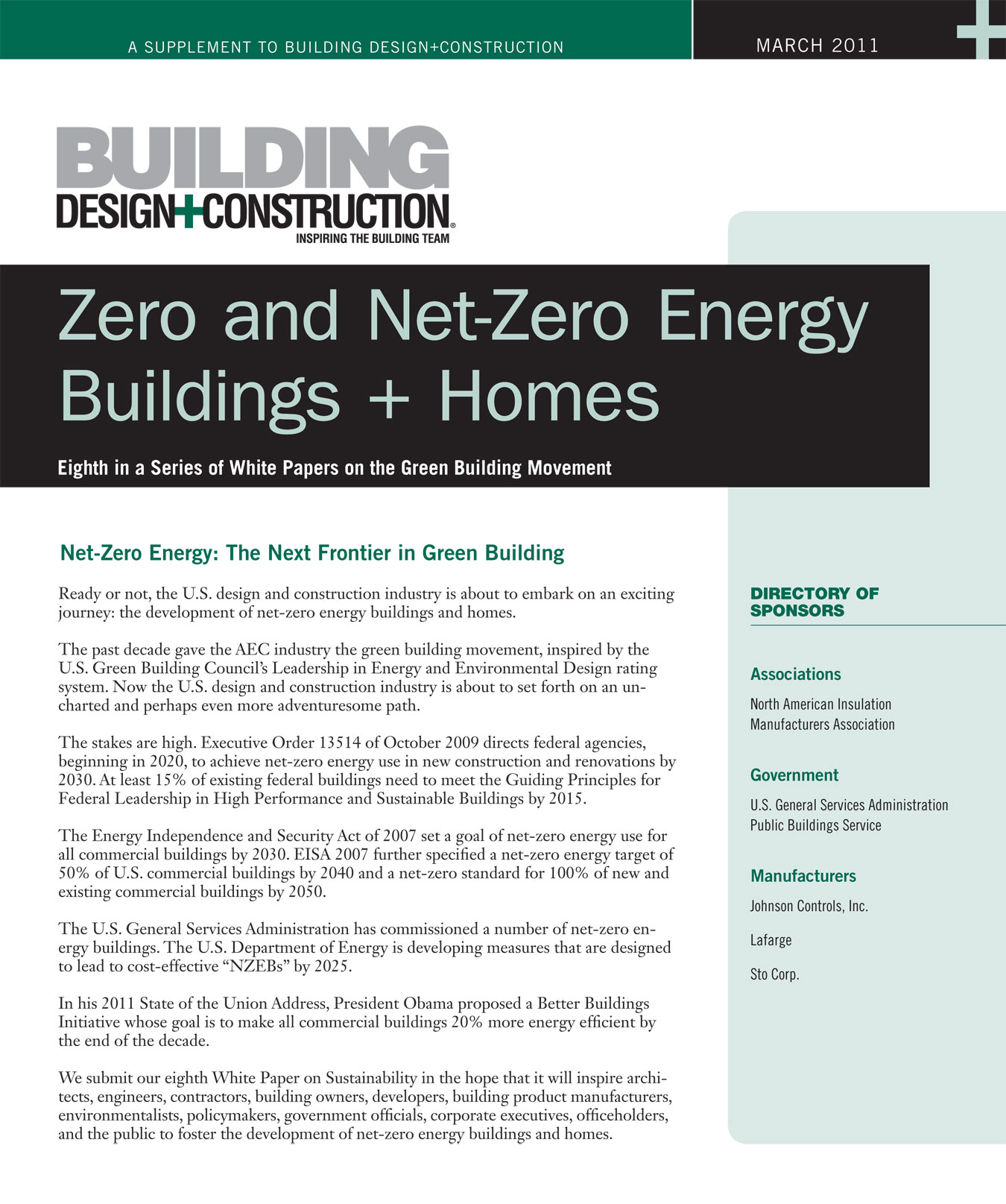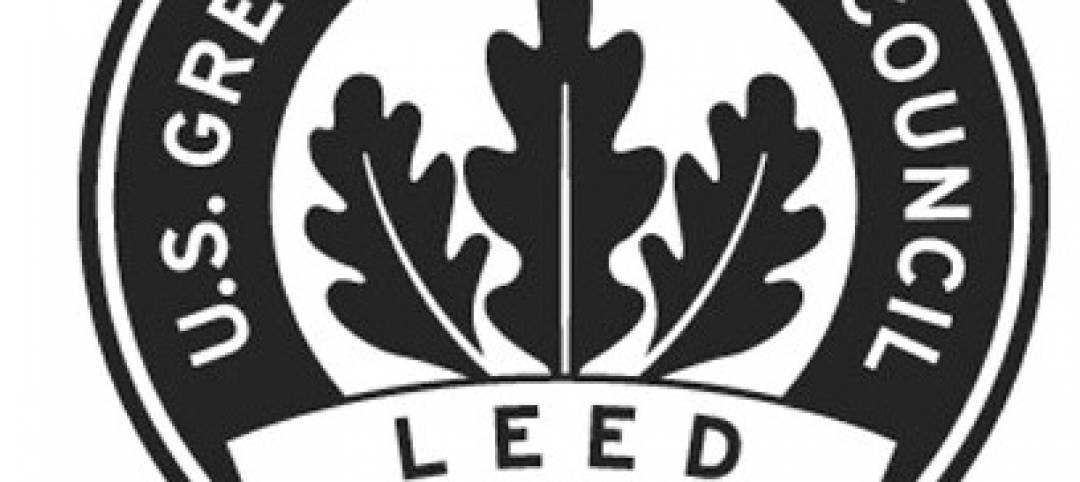“Zero and Net-zero Energy Buildings + Homes,” a 64-page White Paper that proclaims “the next frontier in the green building movement,” will be the topic of a 1-hr Q&A with 6 “NZEB” experts at the AIA Conference + Expo, Friday, May 13, 11 a.m. to 12 noon, at the Morial Convention Center (Level 2, Room R06), New Orleans.
The 40,000-word report from Building Design+Construction provides a road map for the $350 billion design, construction, and real estate industry to develop “net-zero” buildings and homes that generate as much energy as they use, such as the new Research Support Facility at the National Renewable Energy Laboratory, in Golden, Colo.
Robert Cassidy, BD+C’s editorial director, will moderate the discussion with the panel:
- Paul Torcellini, PE, PhD – U.S. Dept of Energy and National Renewable Energy Lab
- Tom Hootman, AIA, LEED AP – RNL Design (Research Support Facility design team)
- Philip Macey, AIA, LEED AP – Haselden Construction (Research Support Facility construction manager)
- Marc L’Italien, FAIA, LEED AP – EHDD Architecture (Exploratorium, Packard Foundation, and several other net-zero energy projects)
- Mary Ann Lazarus, FAIA, LEED AP – HOK (net-zero carbon prototype)
- David Eijadi, FAIA, LEED AP BD+C – The Weidt Group (environmental building consultant for Science House/Science Museum of Minn., net-zero carbon prototype)
Potential topics of discussion (questions from media representatives are welcome!):
- What did the experts learn from their NZEB experiences? What advice do they have for future NZEB designers, contractors, and building owners/developers?
- How do you measure and monitor the actual performance of NZEBs?
- What’s the “business case” for NZEBs? Do they make financial sense for owners?
- Is there a gulf between what the energy model predicts and actual outcome?
- What are the impediments – technical and otherwise – to producing NZEBs?
- What about net-zero energy (and net-zero carbon) for existing buildings?
The White Paper, along with seven previous reports devoted to green building, is available for free download at www.BDCnetwork.com/whitepapers.
The report was sponsored by Johnson Controls, Lafarge, North American Insulation Manufacturers Association, Sto Corp., and the U.S. General Services Administration.
Contact: Robert Cassidy, BD+C Editorial Director, rcassidy@sgcmail.com, 847-391-1040 office; 773-220-3555 mobile – Booth 142 at AIA
Related Stories
| Mar 2, 2011
New ASHRAE standard may be too broad for the Canadian market
New Standard 189.1 from the American Society of Heating, Refrigeration, and Air-conditioning Engineers (ASHRAE), which goes beyond energy efficiency to include provisions that affect construction, post-occupancy monitoring, and site control, may be too much for the Canadian market—at least for now.
| Mar 2, 2011
Top 10 states for LEED green buildings
According to the U.S. Green Building Council's 2010 list of top 10 states for LEED-certified commercial and institutional green buildings per capita (based on the U.S. 2010 Census information), the District of Columbia leads the nation, with 25 square feet of LEED-certified space per person in 2010. Nevada, being the leading state, has 10.92 square feet per person in 2010.
| Mar 2, 2011
The extraordinary growth of green building—A rebuttal to an article on why green building adoption is slow
In this rebuttal to The Green Building Adoption Rate is Slow, Find Out The Practical Reasons Why, the author argues that in fact the growth rate has been very high and that much of it came during a time of economic unrest and tight capital, which makes it all the more extraordinary.
| Mar 1, 2011
Smart cities: getting greener and making money doing it
The Global Green Cities of the 21st Century conference in San Francisco is filled with mayors, architects, academics, consultants, and financial types all struggling to understand the process of building smarter, greener cities on a scale that's practically unimaginable—and make money doing it.
| Mar 1, 2011
USGBC's new LEED Interpretations similar to old precedent-setting CIRs
This week the USGBC launched its long-awaited LEED Interpretations process and database. LEED Interpretations are like project-specific Credit Interpretation Rulings, but unlike those CIRs, they can be applied to multiple projects. LEED project teams with a unique situation or a question not answered by existing LEED resources have had access to CIRs since 2009, but those CIRs have been limited. With the launch of LEED Interpretations, the USGBC hopes to broaden its scope.
| Feb 25, 2011
Denver excelling in LEED green building development
The mile high city has a decidedly green tinge. The U.S. Green Building Council (USGBC) today noted that nearly 30 projects in Denver have achieved LEED green building certification since 2010 and two of these developments achieved LEED’s highest rating, Platinum.
| Feb 25, 2011
Procter & Gamble will pursue LEED for all new sites globally
Procter & Gamble will pursue LEED certification for all new sites. P&G's Taicang plant in China - which is breaking ground today - is the first P&G manufacturing site to pursue LEED certification, with several additional new P&G sites currently working toward the same distinction globally.
| Feb 24, 2011
Perkins+Will designs 100 LEED Certified buildings
Perkins+Will announced the Leadership in Energy and Environmental Design (LEED) certification of its 100th sustainable building, marking a key milestone for the firm and for the sustainable design industry. The Vancouver-based Dockside Green Phase Two Balance project marks the firm’s 100th LEED certified building and is tied for the highest scoring LEED building worldwide with its sister project, Dockside Green Phase One.
| Feb 24, 2011
New reports chart path to net-zero-energy commercial buildings
Two new reports from the Zero Energy Commercial Buildings Consortium (CBC) on achieving net-zero-energy use in commercial buildings say that high levels of energy efficiency are the first, largest, and most important step on the way to net-zero.








